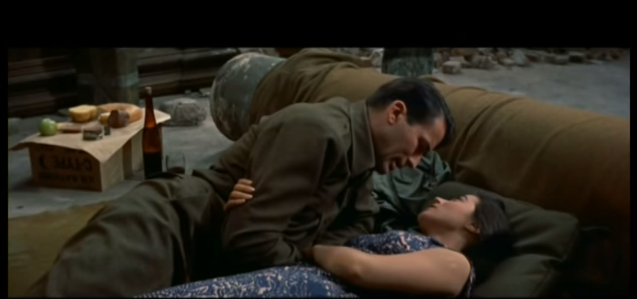Ernest Hemingway thought Sloan Wilson’s The Man in the Gray Flannel Suit was trash. However, Americans still readjusting to World War Two and its aftermath thought made it a best-seller. Within a year of publication, Nunnally Johnson directed a faithful film adaptation. Without a reason, Ernest Hemingway thought Sloan Wilson’s The Man in the Gray Flannel Suit was trash. However, Americans still readjusting to World War Two and its aftermath thought otherwise. It was a best-seller, and Nunnally Johnson faithfully adapted it for the movies. Perhaps Hemmingway faulted Sloan’s description of Tom Rath’s romantic tryst with his mistress Maria in a ruined villa on the outskirts of Rome. It’s a tender episode, without steamy sex, suitable for 1950s mainstream fiction.
On a cold rainy afternoon, Tom Rath and Maria Montagne stumble into a deserted villa for a romantic tryst. Rath lights a fire in the villa’s small library. They spread a ruined tapestry on the stone floor and unpack the picnic basket full of sandwiches, a cold roast chicken, and a bottle of wine. Only when they are finished does Maria remind Rath that they ought to make love, at which point Maria “unbuttoned her jacket and opened her blouse. Partly exposing her breasts and the deep valley between them.” On a wave of passion, Rath cries, “Oh, God. I love you.”
*The image of the man in the gray flannel suit is so strong that it has outlived the novel and become a symbol of mid-twentieth Century America, a rising generation of white, well-educated men striving for wealth and power. On the verge of success, Tom has to face his wife, Betsy, with the knowledge of his affair with Maria.
Featured Image: Tom Rath (Gregory Peck) and Maria Montagne (Marissa Pavan) make themselves a picnic. Nunnally Johnson. The Man in the Gray Flannel Suit
See Sloan Wilson. The Man in the Gray Flannel Suit. New York: Simon and Schuster, 1955; Nunnally Johnson. The Man in the Gray Flannel Suit (1956). The screenplay by Nunnally Johnson is based on Sloan Wilson’s 1955 novel. Ernest Hemingway. November 14, 1955, in Selected Letters 1917-1961. Edited by Carlos Baker. New York: Charles Scribner’s Sons, 1981

